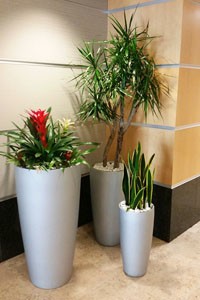
Interior conditions should support plant health
Sometimes the best approach to preserve a plant’s beauty and the quality of an interiorscape design is to focus on the environmental conditions that may be causing a plant to deteriorate. In order to correct the situation, you must first determine the cause of the underlying stress and change or correct the condition. This type of strategy is a long-term, proactive approach rather than a short-term, quick fix. By incorporating an indirect control strategy into your plant management program, you increase the odds of keeping newly installed plants pretty and vital while preventing plant replacements.
Evaluate the overall design
Even the most carefully designed planting can develop surprising challenges when installed in an account. Evaluate the interiorscape design and make necessary changes if environmental conditions jeopardize plant health.
- New pedestrian traffic patterns: Replace easily damaged plants such as Spathiphyllum and Dracaena massangeana with plants able to withstand some mechanical damage like Aspidistra. Try narrow-leafed plants such as palms or use plants that take up less space such as a narrow, columnar Dracaena marginata.
- Changes in light intensity, duration or quality: Replace plants requiring very specific light levels with plants adaptable to a wider range of light levels; i.e. Ficus benjamina versus the more tolerant lyrata. Adjust light levels by asking the client to work with you in controlling the light source. Window glazing or shades reduce bright areas; requesting that lights be left on or blinds opened increase light levels.
- Temperature/humidity fluctuations: Work with your client to remedy situation-causing stress. Redirect heat/AC vents; relocate plants to cooler, more humid locations; group plants to raise humidity; add a heating source to cold atriums.
Use pest-resistant plants and products
Replace highly susceptible plants with varieties more resistant to pest infestations. Try these substitutes:
- Palms: Though all are susceptible to mites, the coarser, thicker-leafed palms such as Caryota mitis, Rhapis excelsa and Howeia forsteriana are more resistant to mites than their thinner-leafed relatives.
- Different varieties within the same species: Some varieties are more resistant to pests. A few of the hardier varieties include Ficus retusa and Ficus stricta ‘Nuda.’
- Supplemental nutrients: Silicon solution added to plants can make them more resistant to fungus and insect pest attacks.
Alternate sources of infestation
Chronic infestations may be caused by repeated exposure from an outside source. Be aware of the following possibilities:
- Infested staging materials and jardinieres: Pests can live and hide in the moss and foam rubber staging, and crawl on the pots themselves. Be sure and replace the moss and thoroughly wash the decorative container when treating the infestation or when making a replacement.
- Carriers: You may inadvertently carry pests on your hands, apron, shirt or even in your hair. Wash hands and clothing in hot soapy water to get rid of eggs and living pests; tie back long hair when working with infested plants.
- Personal plants: Check personal plants belonging to clients for signs of infestations. Depending on your contractual obligations, you may be able to have the plant removed or treated. Remember to be sensitive to the client’s feelings about their plants and use your best customer service skills to talk your way through this delicate situation.
- Infested tools: Pruners, scissors, watering spouts, duster, cleaning mitts, sponges and soil probes can carry pests. Sterilize tools by wiping with alcohol or dipping in a mixture of ¼ bleach to one gallon of water. Soak cleaning materials in bleach mixture; rinse with clear water.
When taking care of plants, it’s important to consider all environmental factors that may affect them. A keen eye and careful planning will ensure healthy plants in all of your accounts!
